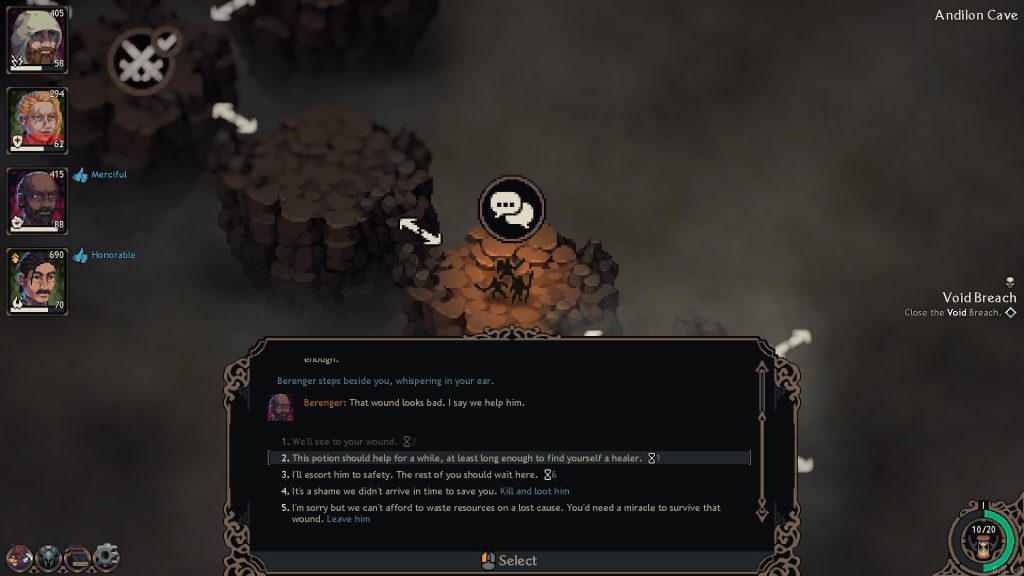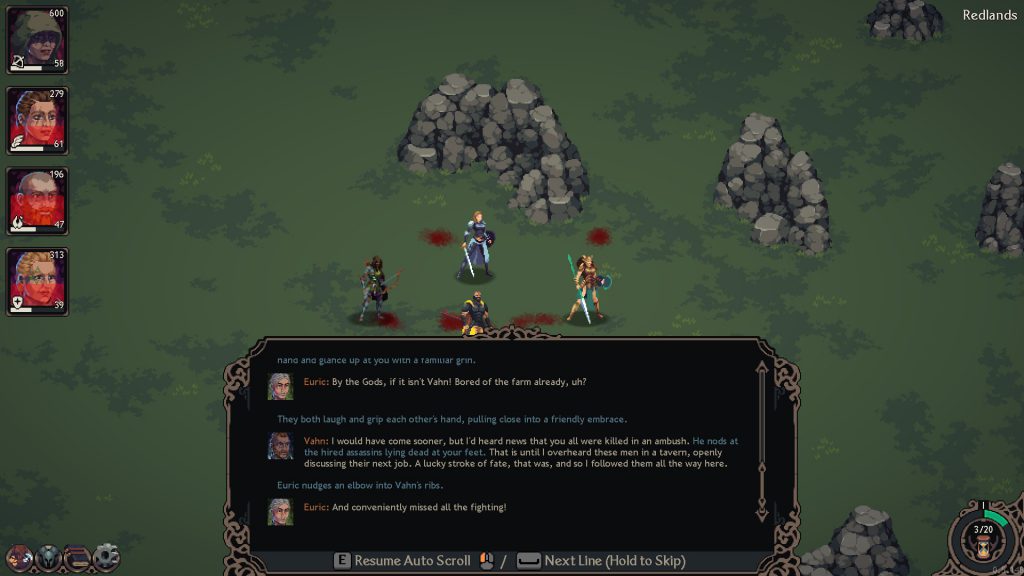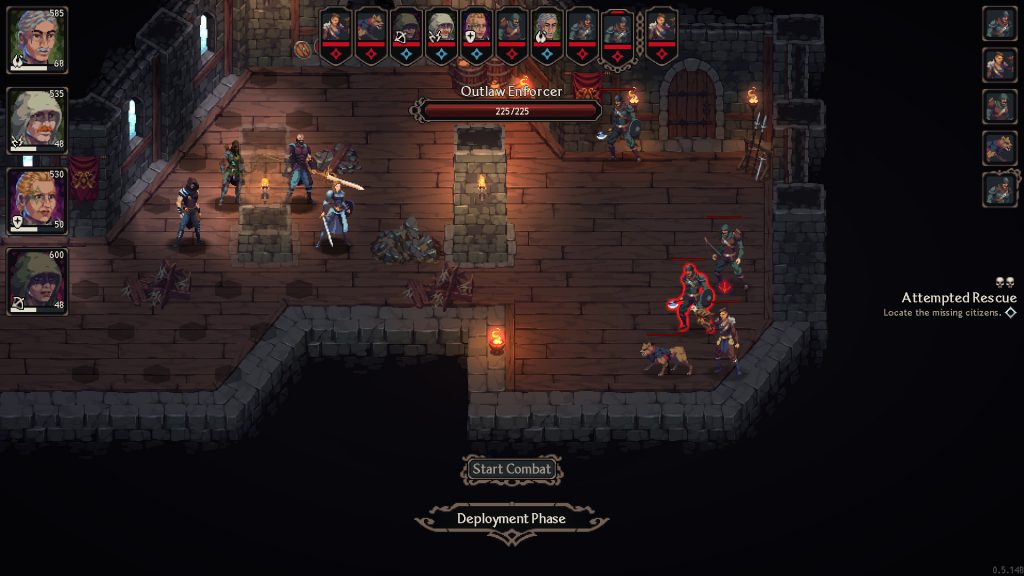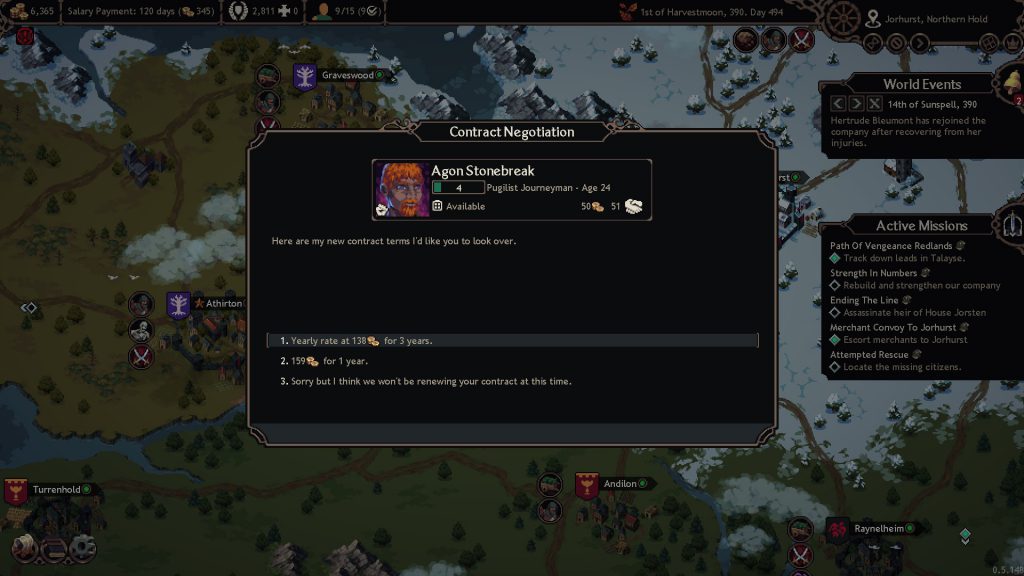The Iron Oath could be a watershed moment for squad-based tactics games
Goodness, it’s hard to be a mercenary leader. Yet, despite that, more and more games are appearing that put you at the helm of your own gang freelancing sword-for-hires. The latest title to let you lead a company of sellswords is The Iron Oath from Curious Panda Games and it’s available now in Early Access.
Between quarrelling nobles, remorseless demons and a giant evil dragon, the world of Caelum needs a hero; sadly they don’t exist. However, if you think about it, the heroes of most party-based RPGs, including pen & paper RPGs, are essentially an unattached band of heroes who go around and complete quests in order to keep their gold balance above zero, the main difference here is that your characters take a wage, and so that’ll have to be close enough. The Iron Oath is a tactical, squad-based game at its heart, following in the steps of games like Wartales, XCOM and Battle Brothers, however much like many of those, there are some traits and features that are more commonly associated with RPGs littered throughout.
The Iron Oath‘s demon-incursion-stricken world actually feels closer to a Baldur’s Gate or Dragon Age-lite setting, and a lot of effort has gone into trying to make each character feel unique as with tactics RPGs; your party members are slipped into messages, and they have conversations mid-contract that almost make it seem like they’re deliberately crafted characters rather than a dice-roll of class, stats, face, colour-palette, name and abilities. They’re not though, they’re procedurally rolled, and as you level them up the characters that share classes might well start to feel incredibly samey, and the messages might start to feel less personal and more repetitive. Part of that is due to the fact that it’s a squad-based, tactics game before all else, but most of it is because it’s only just started on quite a densely-packed year of Early Access development.
Its tutorial, while a little linear, paints a slightly different world than the one you’ll be exploring. A cave dive culminating in a retirement party suddenly shifts into a massacre as your mercenary gang turn on itself for profit. Only you and a couple of company stalwarts remain and immediately form a new company to seek vengeance and rescue a kidnapped child. The thing is, there’s no opportunity for grand betrayals in-game, and writing that plays on those relationships will only happen around scripted events — so it can feel a little light on story at times after such a grand introduction. That said, the dialogue is very well written and Curious Panda Games have clearly made a deliberate effort to make your mercenaries get involved in conversations where they can, and to make them seem like deliberately written companions. As characters in older RPGs would, they act like they have their own concerns and fears, and converse with other characters in your party. Unlike many of those games, your characters can wind up permanently dead, and your mercenaries will comment on it — I’ve had one character permanently die after misjudging a mission, and everybody held a funeral. It’s six of one and half a dozen of another when it comes to the appeal of these clever design choices, they feel novel and new until things start repeating, at which point it’s almost worst than it not being there.

The Iron Oath‘s world, for instance, isn’t procedurally generated (unlike its characters), which feels a bit odd. I’m pretty confident that by the time it reaches 1.0 this won’t feel like an issue, and the way that the cities and towns interact with each other will feel a lot deeper, but at the moment it just eludes to that. There are warring human factions that you can flip between for profit or gain, but you can’t see them (or anybody else) moving on the world map and all fights and skirmishes are small-scale; towns can be affected by monsters, missing villagers or boosted by caravans, but that doesn’t seem to affect the towns beyond cycled quests. Towns certainly don’t seem to grow or wither based on the world around them, something that you might hope a non-procedural world could muster.
This all might sound quite negative, and that’s not deliberate. It’s just really hard to not talk about the potential of this game without discussing it in the state that it’s currently in — in that way it might well be the perfect Early Access game as it’s very playable and so just feels like it’s tweaks, refinements and stacks of content that need pouring onto it before it’s feature complete; Because, if some of that content was already there and in place then, for example, there maybe wouldn’t be enough time for the mind to wonder about why the world isn’t shifting.

Time is incredibly important, not just for the development of The Iron Oath, but also for the characters in the world. In many ways, time is one of the main characters of Caelum. Its citizens are stuck in a perpetual dark age, made worse by the fact that a dragon turns up and smashes stuff up every decade, stirring up the demonic void beasts (as if the looters, raiders and robbers weren’t enough). Nobody’s moving out of a dark age with that much evil rattling around, keeping everybody poor and destitute. But time also has a role in how you interact with your mercenaries; you negotiate contracts with them for years at a time and, well, humans only have so many years, even if they are a particularly hardy adventurer. Your mercenaries will age, they’ll retire and if they don’t then, well, it’s because they’re dead. That said, I’ve not had anybody retire yet, and while a starting companion of mine is clearly ageing and getting close to it, it hasn’t fired just yet and… maybe that’s for the best, I’m quite invested in the idea of rescuing the kidnapped child I mentioned — although part of me does wonder what happens if I take too long to get there, will I find them as an old man, long after my protagonist should have keeled over under the weight of time?
The ageing system is welcome, it’s a very good visual reminder of something that people tend to forget about in games where you can bring in new characters; that you should be training up new characters. It’s plan-crippling when you lose a soldier in any game with permadeath, but how many people actually prepare for that? Not many, I’d imagine. With the dangers of retirement and the portraits of your characters changing as they age, this works as a great reminder to bring in new blood and ensure that you’re levelling up your teams more evenly. There are plenty of opportunities TO level them up, as you can have quite a few missions on the go at once, which can make for quite big paydays if you’re strategic with how you move around the map.

Jobs come in two different varieties. The first are just a case of you moving from one place to another, and then maybe onto a third. The second type are quick dashes to a location, a single fight, and then a trek back to hand in the mission; Finally, the third type are dungeon dives, which have you explore a series of map nodes, complete events and fight enemies until you reach the endpoint. While in the dungeon dives your characters don’t automatically heal to full health between each fight, and can pick up injuries from events or being knocked down — this is The Iron Oath at its best, with you having to item manage and risk manage (you can camp and use ‘incenses’ to add modifiers or heal, but can be jumped by enemies while sleeping) in order to survive a long mission.
Combat, which you’ll have about four-five instances of in most dungeon-dive missions, is really fun and also surprisingly snappy. In fact, if a skirmish takes longer than 5-6 rounds you’re probably in trouble. The Iron Oath‘s combat is small-small; you can only take in four of your fighters and you’ll rarely be against more than five enemies. Each of your characters is a bundle of stats and abilities initially defined by their class, however, as you level them up you can tinker with their stats, unlock new abilities and also tweak those abilities through unlock trees. They feel different too, and while the classes (which I should add, are not standard fantasy classes) do have set character models at the moment, there are more than a few pallette swaps. So I very quickly learnt that X was my Red-Palette Fire-Spearman, and so I’d do well to bring along at least one Paladin. That works really well.

It might be fast, but there’s a lot of strategy at play. Each ability only has a certain number of uses in a dungeon-run, so burning up the double-shot from your bow-wielder, or using all of the healing abilities, early on in the run is a bad idea. There are more than a few ways to defend though, thankfully. For a start, each class has buff and nerf abilities, and a lot of them have area-of-effect or even trap spells, which allow you to command the battlefield. However, there are also half- and full-height objects around the level which are great for stopping ranged attacks. There are also traps, holes and objects on most maps. The traps are normally triggered by being walked on and in the case of snow areas, they can be walked on before giving way but can affect adjacent tiles, causing an entire party to take fall damage and be repositioned as a result. But, that’s not all, because most enemies and player classes can knock their targets around, pinballing them into walls, objects, holes, traps or even other characters to cause extra, collateral damage. On the other hand, you can also pull enemies, and even teleport allies to the side of a certain class; the latter is incredibly powerful because D&D-style attack of opportunity rules are in — so if you try and move away from adjacent enemies they’ll get a free hit in.
Combat feels smooth and well balanced, which is great because it’s quite central to the whole experience. However, there are still a few things in other parts of The Iron Oath that just don’t feel quite as optimised as they could. One pet-peeve in combat is that characters only change facing at certain times; in most 2D tactics games the two fighting factions will be either fixed to a direction, or very clearly marked based on their team, neither is the case here and characters will change facing based on where they moved from rather than where they last attacked. There’s also a crying need for some attention to the menus. When recruiting in the Inn you can’t quickly view your existing teams, and recruitable character classes are only listed by word, while they have very easily understandable icons in the character select menus. Similarly, when shopping in the town there’s no quick equip function. These two things combine to make recruiting a new candidate and then equipping them with items into a much larger effort than it should have been. However, these are exactly the kind of things that could be fixed before it leaves Early Access.

The Iron Oath definitely feels like it’s not just on the right path, but that it’s destined to be held up as an example for tactics games in future — it currently feels like the prologue and 1st chapter of a really, really strong cult-classic title and I can’t wait to see it evolve.
The Iron Oath is available now on Windows PC & Mac.
I watched the trailer and it seem to be interesting. Reasonable price as well.